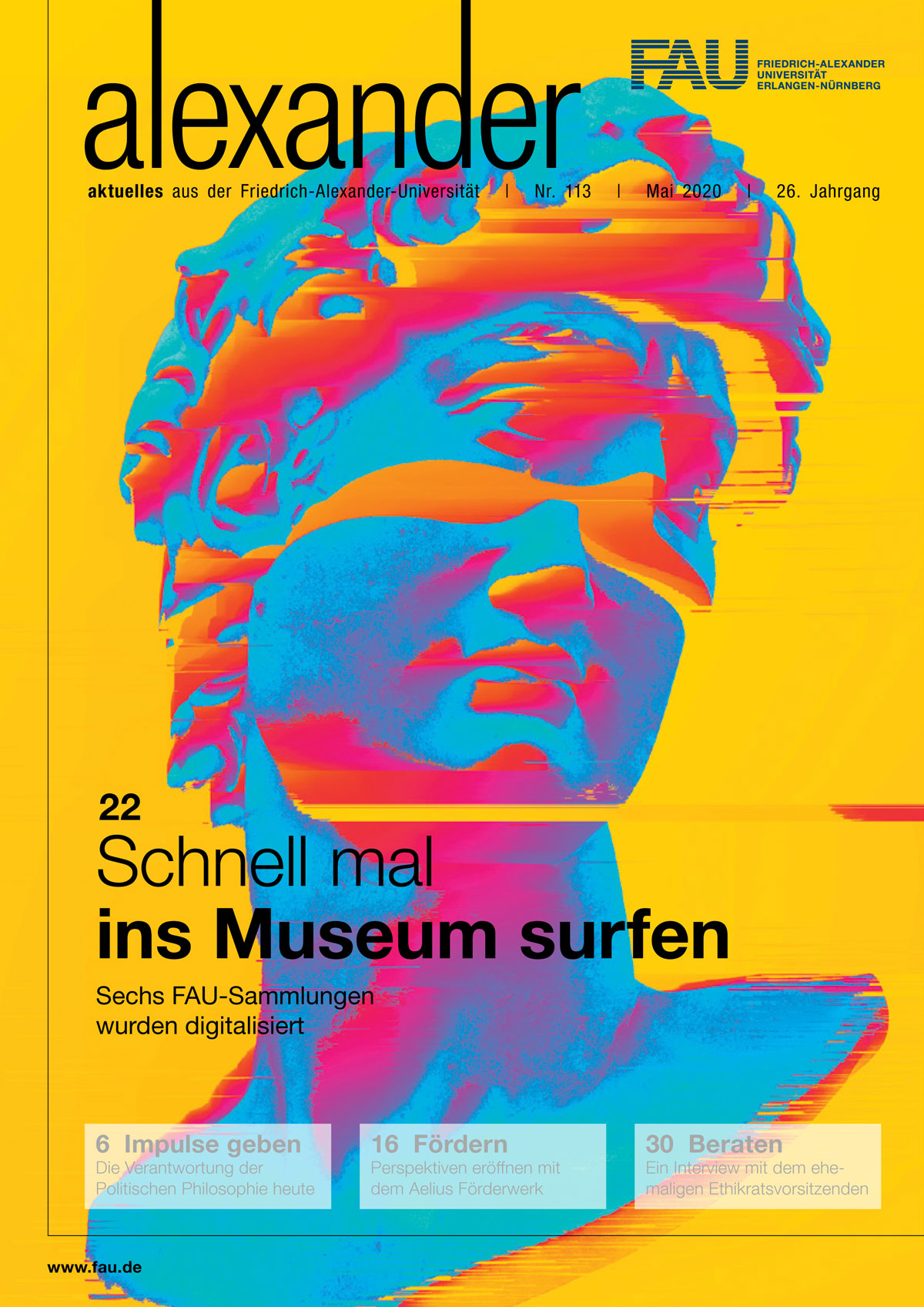Browsing, exploring and researching online
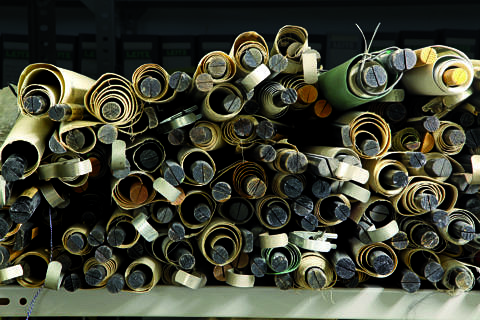
Digitalization of six FAU collections.
What does the digital age mean for scientific collections? This was the subject of research carried out by FAU in conjunction with the Germanisches Nationalmuseum (GNM) in a joint research and digitalisation project called ‘Objekte im Netz’ (Objects on the Net).
Antique coins, medieval musical instruments, preserved body parts, zoological models or priceless drawings are just some examples of the valuable artefacts stored in museums and scientific collections around the world. They are often kept right at the back of the storeroom, deep in the cellar or at the top of the attic as only a small proportion of the objects can be put on permanent display and be made accessible to researchers and the public. ‘Digitalisation opens up a whole new range of possibilities for us in this respect. We just have to use them productively and successfully,’ says Udo Andraschke, director of the central curator’s office at FAU. He knows what he is talking about, as the University and the Germanische Nationalmuseum have recently completed the ‘Objekte im Netz’ (Objects on the Net) project that received 553,000 euros of funding from the Federal Ministry of Education and Research and developed their own central portal allowing researchers to explore related articles and conduct research across FAU’s collections.
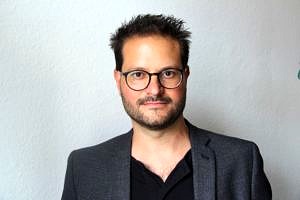
Digital transfer zone
The two institutions worked together on the project for three years, focusing on six collections at FAU: the Collection of Prints and Drawings at the University Library, the Medical Collection, the Palaeontological Collection, the Pre- and Early History Collection, the History of School Education Collection and the Musical Instrument Collection. The latter was transferred in 2010 to the University of Würzburg with the merger of the musicology departments. ‘These collections have been made accessible to varying degrees and the materials, functions and origins of the objects they contain vary greatly,’ explains Andraschke. The advantages are clear: If researchers succeed in systematically recording these very different items, making them accessible online and linking them together, the results could be transferred to other university collections. There are around 1,100 collections distributed among 80 universities across Germany. FAU alone has around 25 collections with a large number of artefacts from a wide range of disciplines, and was one of the first universities in Germany to establish a central curator’s office as early as 2011. Udo Andraschke has been taking care of the objects in the collections since then.
‘Collections have always had a great deal of creative potential. They have always been a meeting place and a place of movement and of exchange, or transfer zones,’ explains Andraschke. ‘However, only virtual collections allow researchers and others across the globe to browse their contents day and night, search for specific objects or simply have a look to see what they can discover.’ Digital transfer zones and virtual research environments are increasing the visibility and accessibility of objects in scientific collections. The opportunities for interaction are often significantly more varied in a virtual room than a physical space, which is entirely in the best interests of the German Council of Science and Humanities (see box). ‘Digital collections change the way we interact with objects, helping us find connections between them or even discover new relationships that we were previously unaware of,’ says Andraschke. ‘For scientific collections, this opens up a whole new opportunity to carry out up-to-date research in historical collections.’ It is this potential which explains why the curator is so keen for the digitalisation of the collections to continue even after the ‘Objects on the Net’ project.
The joy of discovery
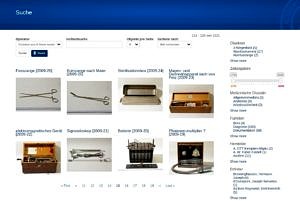
How are the analogue objects put online? The virtual documentation environment WissKI is used by the curation team to document and digitalise the items in the collection. WissKI stands for ‘Wissenschaftliche KommunikationsInfrastruktur’ in German or Scientific Communication Infrastructure and the software was specially developed for recording, researching and publishing cultural heritage. It was developed during two DFG research projects, in which FAU and GNM played a significant role. ‘We have been successfully using the browser-based WissKI software for several years now for digital documentation in the museum,’ says Mark Fichtner, research associate at GNM who is responsible for the technical aspects of the joint research project. Starting with the collections at FAU and normal day-to-day processes, the computer scientist further developed the WissKI software into a virtual collection room in conjunction with two colleagues and several assistants.
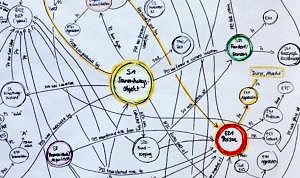
The team of researchers led by Fichtner and Andraschke started by meeting with colleagues from the museum, the collections and the Master’s degree programme Digital Humanities. They moved on to develop a data model that has enabled the collections to be recorded, researched, linked and published. The model comprises around 90 different classes, which are descriptive units such as ‘physical object’ or ‘person’ and 150 properties which are used to describe objects consistently. In addition, the information is contextualised in terms of events to record whether objects are finds, manufactured, inventions, purchased or restored, then placed in historical and spatial contexts and linked to relevant contributing organisations. ‘This concept goes far beyond simply cataloguing artefacts using digital tools,’ emphasises Fichtner. ‘Many relations are created between objects and collections and the more objects that are added to the collection space, the more informative relationships within and between collections become. Researchers are also able to conduct complex queries and advanced search operations.’ Users of virtual collections can examine the digitalised objects from various perspectives, rotate and zoom in on them and compare them thanks to several interactive features. The tools provided by digital technology and the world wide web open up a whole new way of accessing and studying objects.
Udo Andraschke is certain that the project encourages people to be curious and enjoy research. As central curator at FAU, he believes that curiosity and the joy of discovery is the lifeblood of scientific collections. ‘By browsing, exploring and researching online, we often find something we weren’t looking for, which leads us to ask new questions, broaden the scope of our research and obtain new findings.’ This applies to all objects in the collections, be it antique coins, zoological models or valuable drawings.
More information:
http://objekte-im-netz.fau.de/projekt/
alexander – Aktuelles aus der FAU
In der aktuellen Ausgabe geht es um das Digitalisierungsprojekt „Objekte im Netz“, Fledermäuse mit Rucksäcken und die Herausforderungen für die Demokratie durch Bio- und Digitaltechnologie. Außerdem haben wir mit dem FAU-Theologen Prof. Dr. Peter Dabrock über seine Zeit als Vorsitzender des deutschen Ethikrates gesprochen. „Student des Jahres“ Sagithjan Surendra erzählt im Interview von seinem Jugend-Förderwerk und Dr. Axel Adrian vom Lehrstuhl für Strafrecht, Strafprozessrecht und Rechtsphilosophie erklärt, wie Künstliche Intelligenz im Rechtswesen eingesetzt wird.
Einzelne Exemplare liegen an der FAU aus. Gerne können Sie sich das Magazin auch kostenlos nach Hause oder an den Arbeitsplatz schicken lassen. Bitte füllen Sie dafür unser Abo-Formular aus.
Ausgewählte Beiträge können Sie auch online lesen in unserem Blog „FAU aktuell“.
